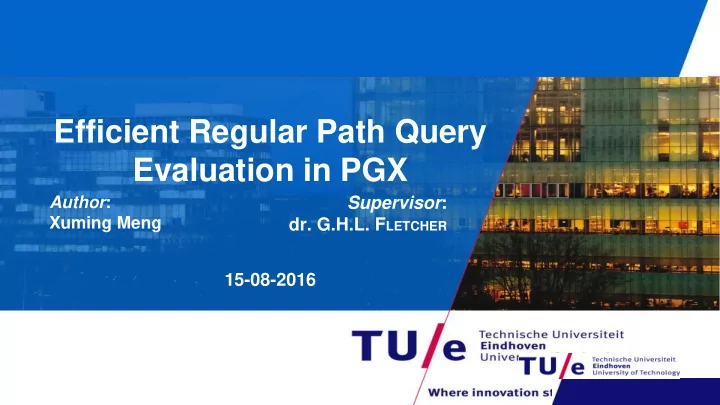

Efficient Regular Path Query Evaluation in PGX Author : Supervisor : Xuming Meng dr. G.H.L. F LETCHER 15-08-2016
Introduction & Problem Statement Regular Path Query ( RPQ ) in PGX . - an in-memory parallel graph analytics framework, developed by Oracle Lab. ● Space requirement ● Performance requirement ● Commitment to deliver result
Introduction & Problem Statement RPQ: (X, knows ∘ like + ∘ (like * ∘ dislike) + , Y) Three types of clauses: ● Non-Kleene star clause, i.e. knows ● Non-nested Kleene star clause, i.e. like + ● Nested Kleene star clause, i.e. (like * ∘ dislike) + Algorithm & possible optimizations: - Naive: search in the graph by standard algorithms, such as BFS or DFS - Cache: speed-up with materialization (space/speed trade-off) - Context-specific: specialized in-memory search
Existing Approaches Index-based ● k -path index ( Fletcher et al. 2016 ) ● Reachability index ( Gubichev et al. 2013 ) Automata-based ● Automata-based approach ( Koschmieder et al. 2012 ) Datalog-based ● Datalog-based relational database ( Saumen C. Dey et al. 2013 ) Transitive Closure-based ● Full Transitive Closure ( Rakesh Agrawal 1988 ) General Drawbacks - Large potential intermediate results - Impractical precomputation cost
RPQ Operator Design How to adapt transitive closure algorithms to solve non-nested Kleene star clause on labeled digraphs?
RPQ Operator Design RPQ: (X, dislike + , Y ) Reachability Graph ( R.G. ) Materializing dislike
RPQ Operator Design Question: what if there is not enough memory for R.G.? Virtual Reachability Graph Materializing dislike
Size Estimation Overview Non-Kleene - Capturing correlations between labels in paths is critical to a precise estimate - We adopt the method in ( Ashraf Aboulnaga et al. 2001 ) that captures certain degree of co-relationship between edge labels in paths Kleene star - Need estimates for transitive closures, E.g. like + - Traditional methods produce poor estimates due to lack of deduction - We use min-hash sketch ( Edith Cohen, 1997 ) for estimation
RPQ Life Cycle Clause RPQ input Obtain clause type Nested Kleene Query Plan Non-Kleene star R.G size estimate star clause clause evaluation evaluation Y R.G. Construction Next clause available TC evaluation N Return result Result merging
RPQ Operator Implementation Depending on whether the R.G. has small-world property - Bitmap-based BFS ( M. Yang and C. Zaniolo, 2014 ) - Multi-source BFS ( M. Then et al., 2014 )
Experiments & Result analysis Objectives ● Effectiveness of materializing reachability graph. ● Performance impact of reachability graph construction. ● Performance impact of reachability graph type and algorithm choice NOTICE: All queries are designed with Kleene star clause Below, only results from LDBC dataset are presented.
Experiments & Result analysis
Experiments & Result analysis
Conclusion & Future work Achievement ● Boosting RPQ evaluation using partial materialization ● Switching physical TC operator depending on graph type ● Trading performance for space if necessary Possible Improvement ● A better query estimation method ● An efficient in-memory RPQ evaluation solution without R.G. ● Facilitating graph traversal with effective cache usage
Thank You
Recommend
More recommend